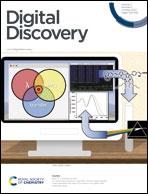Site-Net: using global self-attention and real-space supercells to capture long-range interactions in crystal structures†
Abstract
Site-Net is a transformer architecture that models the periodic crystal structures of inorganic materials as a labelled point set of atoms and relies entirely on global self-attention and geometric information to guide learning. Site-Net processes standard crystallographic information files to generate a large real-space supercell, and the importance of interactions between all atomic sites is flexibly learned by the model for the prediction task presented. The attention mechanism is probed to reveal Site-Net can learn long-range interactions in crystal structures, and that specific attention heads become specialised to deal with primarily short- or long-range interactions. We perform a preliminary hyperparameter search and train Site-Net using a single graphics processing unit (GPU), and show Site-Net achieves state-of-the-art performance on a standard band gap regression task.



 Please wait while we load your content...
Please wait while we load your content...